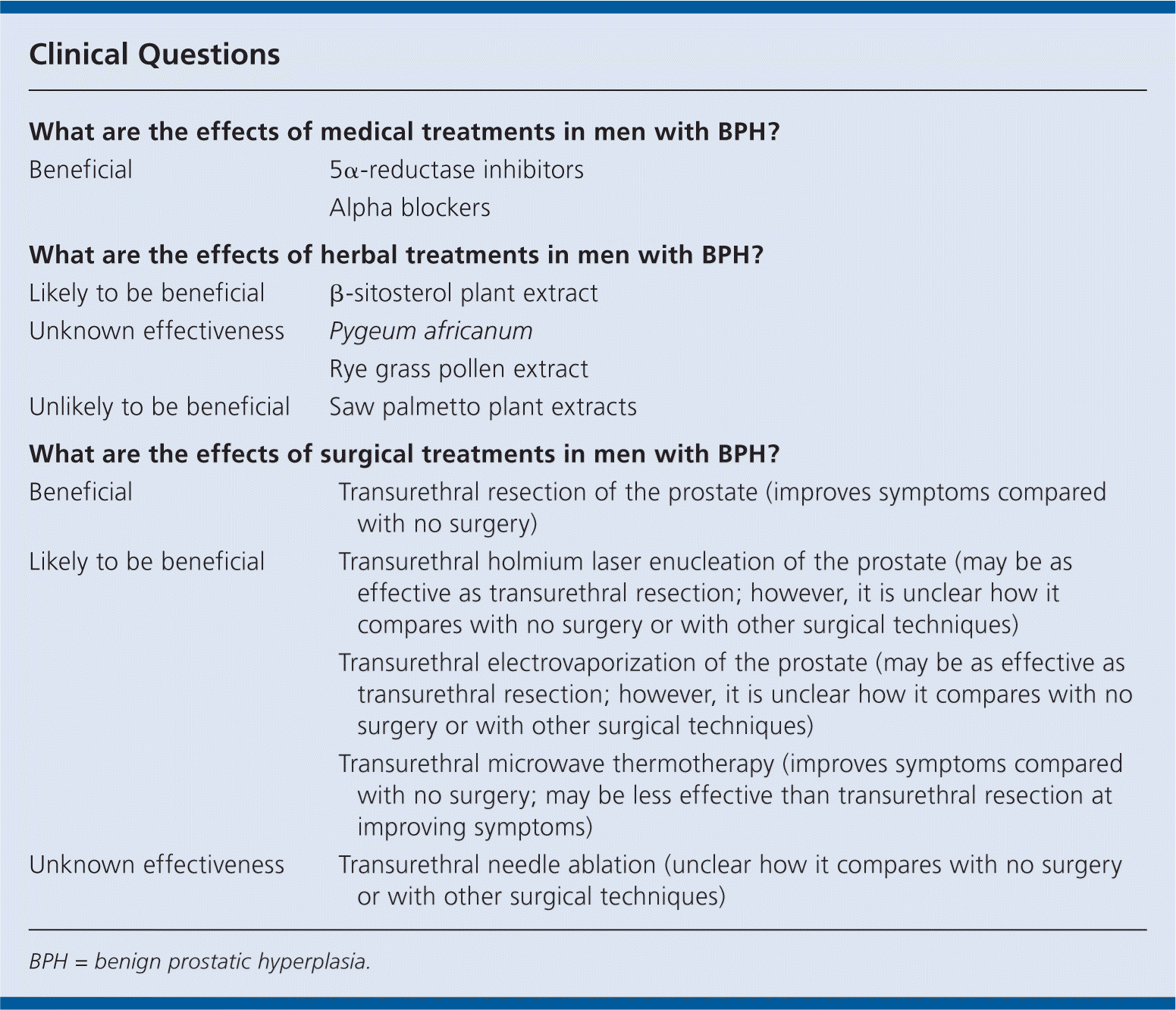
Am Fam Physician. 2012;86(4):359-360
Author disclosure: Tom McNicholas and Roger Kirby have been reimbursed by Astellas, GSK, Pfizer, and MSD for attending conferences, for lecturing, and for the expenses of research studies.
Symptomatic benign prostatic hyperplasia (BPH) may affect up to 30 percent of men in their early 70s, causing urinary symptoms of bladder outlet obstruction.
Symptoms can improve without treatment, but the usual course is a slow progression of symptoms, with acute urinary retention occurring in 1 to 2 percent of men with BPH per year.
Alpha blockers improve symptoms compared with placebo and more rapidly than with finasteride, and may be most effective in men with more severe symptoms of BPH or with hypertension.
Caution: A drug safety alert has been issued on the risk of intraoperative floppy iris syndrome during cataract surgery with tamsulosin and probably with other alpha blockers. Persons taking an alpha blocker should inform their eye surgeon.
5α-reductase inhibitors (finasteride and dutasteride) improve symptoms (especially with longer duration of treatment) and reduce the risk of complications of BPH compared with placebo, and are more effective in men with larger prostates.
Caution: A drug safety alert has been issued on the risk of male breast cancer with finasteride. Changes in breast tissue such as lumps, pain, or nipple discharge should be promptly reported for further assessment.
Saw palmetto plant extracts may be no more effective than placebo at improving symptoms. However, evidence was weak, and further good-quality long-term randomized controlled trials are needed.
Compared with placebo, β-sitosterol plant extract may improve symptoms of BPH in the short term.
We do not know whether rye grass pollen extract and Pygeum africanum are also beneficial, as few studies were found.
Transurethral resection of the prostate (TURP) improves symptoms of BPH more than watchful waiting, and has been shown not to increase the risk of erectile dysfunction or incontinence.
Some less invasive surgical techniques such as transurethral incision, laser ablation, transurethral holmium laser enucleation, and transurethral electrovaporization seem to be as effective as TURP at improving symptoms.
TURP may be more effective at improving symptoms and preventing retreatment compared with transurethral microwave thermotherapy, but causes more complications.
Transurethral microwave thermotherapy reduces symptoms compared with sham treatment or with alpha blockers, but long-term effects are unknown.
We do not know whether transurethral needle ablation is effective.

| What are the effects of medical treatments in men with BPH? | |
| Beneficial | 5α-reductase inhibitors Alpha blockers |
| What are the effects of herbal treatments in men with BPH? | |
| Likely to be beneficial | β-sitosterol plant extract |
| Unknown effectiveness | Pygeum africanum |
| Rye grass pollen extract | |
| Unlikely to be beneficial | Saw palmetto plant extracts |
| What are the effects of surgical treatments in men with BPH? | |
| Beneficial | Transurethral resection of the prostate (improves symptoms compared with no surgery) |
| Likely to be beneficial | Transurethral holmium laser enucleation of the prostate (may be as effective as transurethral resection; however, it is unclear how it compares with no surgery or with other surgical techniques) |
| Transurethral electrovaporization of the prostate (may be as effective as transurethral resection; however, it is unclear how it compares with no surgery or with other surgical techniques) | |
| Transurethral microwave thermotherapy (improves symptoms compared with no surgery; may be less effective than transurethral resection at improving symptoms) | |
| Unknown effectiveness | Transurethral needle ablation (unclear how it compares with no surgery or with other surgical techniques) |
Definition
Benign prostatic hyperplasia is defined histologically. Terms such as prostatism, symptoms of BPH, and clinical BPH have previously been used to describe male lower urinary tract symptoms (LUTS). These descriptions incorrectly imply that urinary symptoms in men arise from the prostate. The acronym LUTS was introduced to avoid this. Increasingly, scientific communications on this syndrome use the term LUTS and avoid the use of the global term BPH. Nevertheless, BPH remains familiar to and is commonly used by family physicians, other clinicians, and patients when searching for clinical information and guidance. Clinically, the syndrome is characterized by symptoms such as urinary frequency, urgency, a weak and intermittent stream, needing to strain, a sense of incomplete emptying, and nocturia. It can lead to complications, including acute urinary retention.
Incidence and Prevalence
Estimates of the prevalence of symptomatic BPH range from 10 to 30 percent for men in their early 70s, depending on how BPH is defined.
Etiology and Risk Factors
The mechanisms by which BPH causes symptoms and complications are unclear, although bladder outlet obstruction is an important factor. The best documented risk factors are increasing age and normal testicular function.
Prognosis
Community- and practice-based studies suggest that men with LUTS can expect slow progression of symptoms. However, symptoms can wax and wane without treatment. In men with LUTS secondary to BPH, rates of acute urinary retention range from 1 to 2 percent per year.
